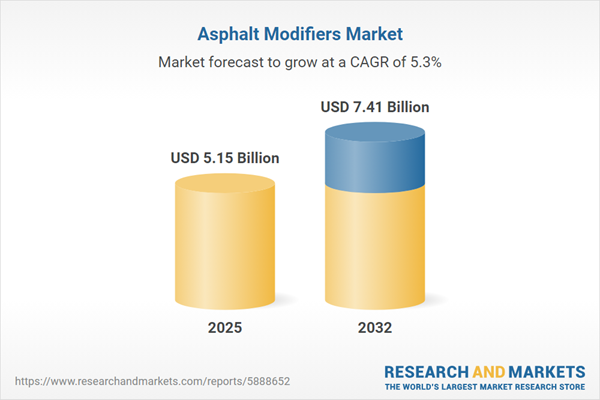Speak directly to the analyst to clarify any post sales queries you may have.
Senior leaders navigating today’s complex construction landscape require innovative ways to comply with tighter regulations and prioritize asset longevity. The asphalt modifiers market offers targeted solutions that boost operational reliability, support sustainability, and address evolving compliance requirements, making it critical for infrastructure executives assessing strategic materials.
Market Snapshot: Asphalt Modifiers Market Growth and Dynamics
The asphalt modifiers market is experiencing consistent expansion, underpinned by a current valuation of USD 4.89 billion and a projected compound annual growth rate (CAGR) of 5.32%. By 2032, the market value is expected to reach USD 7.41 billion. This trajectory is driven by sustained global infrastructure investments along with a rising emphasis on incorporating high-performance, eco-efficient materials. As environmental compliance becomes a focal point, market developments favor the uptake of advanced, responsible technologies. Senior decision-makers are pursuing forward-looking sourcing and operational approaches to meet escalating construction and sustainability demands.
Scope & Segmentation: Defining the Asphalt Modifiers Market
- Modifier Types: Biopolymers contribute to sustainability goals; crumb rubber boosts road flexibility and furthers recycling efforts; chemical modifiers such as Maleic Anhydride and Polyphosphoric Acid enable scalable enhancements; polymer additives like Ethylene Vinyl Acetate and Styrene Butadiene Rubber support tailored project specifications and financial discipline.
- Applications: Essential across roads, airport runways, bridges, tunnels, parking structures, and roofing. These solutions deliver durable, waterproof, and reliable assets vital for both commercial and public infrastructure portfolios.
- Technologies: Cold mix asphalt supports lower energy consumption and aligns with climate objectives; polymer-modified asphalt withstands heavy traffic and challenging field conditions; crumb rubber technology extends service life; warm mix approaches optimize application efficiency while meeting regulatory expectations.
- Form: Liquid modifiers streamline application tasks on-site, whereas powder variants facilitate precise dosing and supply chain flexibility, empowering managers to adapt to diverse environments.
- End Users: Construction companies rely on modifiers for compliance and certification initiatives; government agencies focus on extending infrastructure lifespans; oil companies utilize advanced formulations to maintain bitumen consistency across variable situations.
- Regions: Robust demand is observed in the Americas, Europe, Middle East, Africa, and Asia-Pacific. Each region presents unique adoption dynamics shaped by funding, regulation, and supply chain strategy.
- Key Companies: Industry progress is shaped by BASF SE, Arkema S.A., Dow Inc., Evonik Industries AG, Kraton Corporation, Lubrizol Corporation, Akzo Nobel N.V., ExxonMobil Corporation, TotalEnergies SE, and Shell plc, recognized for propelling innovation and sector collaboration.
Key Takeaways for Senior Decision-Makers
- Integrating asphalt modifiers helps organizations advance asset maintenance protocols in line with modern sustainability priorities and compliance standards, securing long-term infrastructure value.
- Structured collaboration with regulatory bodies, contractors, and research organizations speeds the adoption of emerging products and enhances responsiveness to evolving project requirements.
- Applying digital monitoring solutions enables leaders to gain proactive control over asset lifecycles, resulting in higher operational precision and improved management within complex portfolios.
- Customizing supply chains and technology selections to specific regions minimizes vulnerability to policy changes and logistical challenges.
- Building reliable supplier and distribution relationships protects material availability and helps ensure timely project completion in shifting market environments.
Tariff Impact: Adaptation in Supply Chain and Cost Structures
U.S. tariffs on core raw materials have prompted asphalt modifier producers to reassess sourcing priorities. This has led to an increased focus on domestic production and establishing diversified partnerships, designed to strengthen operational continuity and reduce risk amid fluctuating international trade scenarios, ensuring consistent supplies for developers and contractors.
Methodology & Data Sources
This report synthesizes data drawn from sector-leading datasets, technical studies, and feedback from experienced senior executives and market specialists. All insights have undergone verification to deliver actionable, dependable guidance for infrastructure and supply chain leaders addressing today’s market realities.
Why This Report Matters
- Enables senior decision-makers to proactively recalibrate supply chain strategies when facing regulatory and market shifts inherent to the asphalt modifiers sector.
- Furnishes actionable segmentation by application and regional market, supporting targeted investment and effective risk mitigation.
- Equips leaders with practical direction for driving efficient project execution, adapting governance, and maintaining ongoing regulatory compliance.
Conclusion
This analysis supports decision-makers in optimizing material choices, tracking regulatory movements, and advancing operational excellence, helping them deliver sustainable and resilient infrastructure within a dynamic market framework.
Additional Product Information:
- Purchase of this report includes 1 year online access with quarterly updates.
- This report can be updated on request. Please contact our Customer Experience team using the Ask a Question widget on our website.
Table of Contents
3. Executive Summary
4. Market Overview
7. Cumulative Impact of Artificial Intelligence 2025
Companies Mentioned
The companies profiled in this Asphalt Modifiers market report include:- BASF SE
- Arkema S.A.
- Dow Inc.
- Evonik Industries AG
- Kraton Corporation
- Lubrizol Corporation
- Akzo Nobel N.V.
- ExxonMobil Corporation
- TotalEnergies SE
- Shell PLC
Table Information
| Report Attribute | Details |
|---|---|
| No. of Pages | 180 |
| Published | November 2025 |
| Forecast Period | 2025 - 2032 |
| Estimated Market Value ( USD | $ 5.15 Billion |
| Forecasted Market Value ( USD | $ 7.41 Billion |
| Compound Annual Growth Rate | 5.3% |
| Regions Covered | Global |
| No. of Companies Mentioned | 11 |









